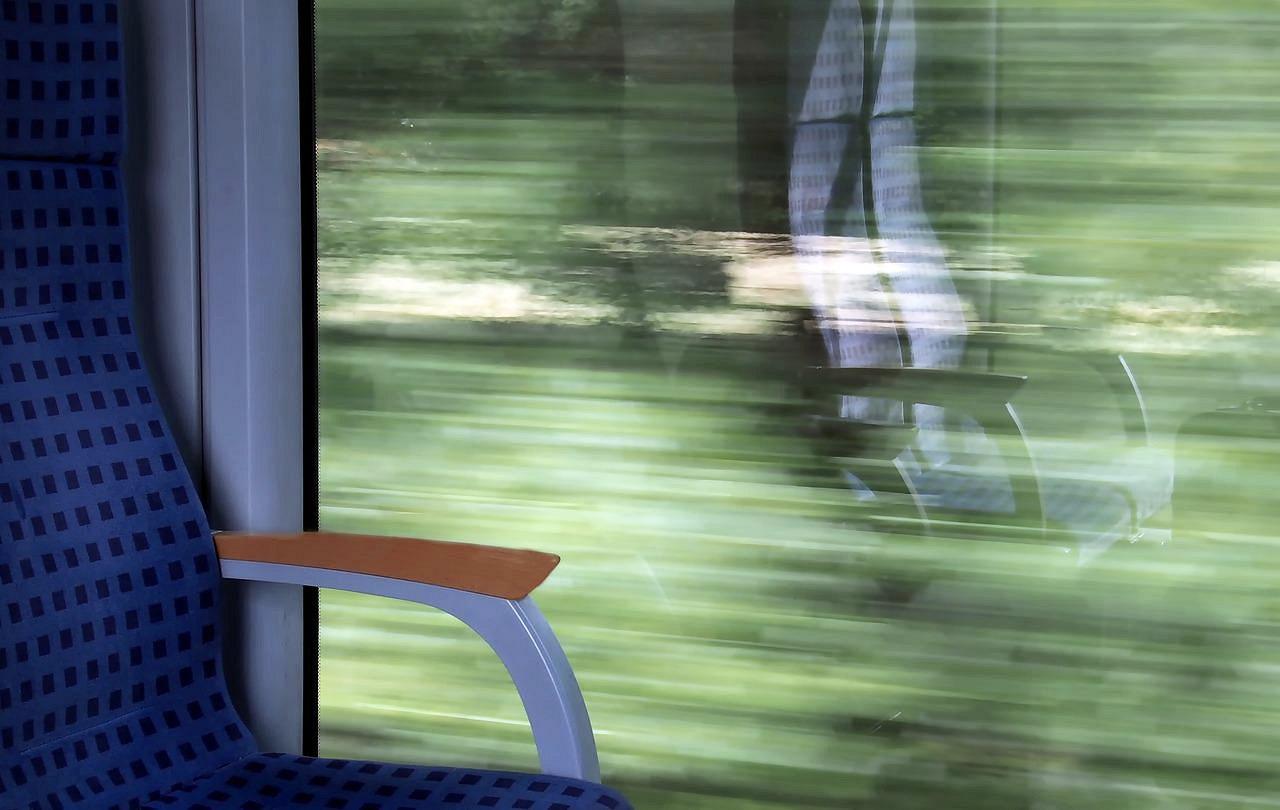Home › Forums › Standing Out in the Field › Destination Unknown
- This topic has 0 replies, 1 voice, and was last updated 05/01/2022 at 7:53 AM by Michael Gray.
-
AuthorPosts
-
-
May 1, 2022 at 7:53 am #951

Photo: ‘Conducting Temporal Sameness’ by kie-ker – Pixabay https://pixabay.com/photos/train-travel-seat-window-mirrors-1360740/
There is something about long journeys to new places; the memories always stay with us. As well as the Amtrak trips I have taken both east and west of Albuquerque, I remember a sojourn to western Canada on a one-way ticket with my friend Paul. I also recollect the trip I took with my mother in Ireland: sitting in the front seat in the upper level of a double-decker bus, looking out at the rolling fields with stone fences dividing one from another. That was a last hurrah for us, before the effects of Alzheimer’s would put such an adventure beyond her reach.
Now I’m on a different train ride, travelling across the territory of my life.
Looking around, I discover that the cars on this train are not just the double-decker observation cars and sleeper cars I remember from my Amtrak and Trans Canada cross-country trips. Here on this Train of Life, the cars have many more levels. At any one point in time, I seem to be able to go forward, backward, up and down, without ever reaching an end point.
Sometimes, I walk back toward the “end” of the train, hoping to look out over the terrain this moving journey has already traversed, but this yields another curiosity. No matter how many times I try, I have yet to reach a platform on the back of the very last car.
Other times, I go up several levels in one of the cars, climbing a spiral staircase which you, too, fellow traveler, are bound to reach if you walk for any distance in any direction. However, no matter how many levels I go up or down, I eventually give up my exploration—not because my legs have grown tired, but because I start to doubt that I’m seeing anything new or that I am able to really appreciate what I am already encountering.
As I wander through the train, everything I see and encounter seems familiar, as if each car is a replica of the others with only minor differences. I’m tempted to think that I’m better off, at least more likely to discover something surprising—even if that sense of surprise is distressingly transient—if I just look out the window from whatever coach I’m sitting in at the moment. For on this Train of Life, it seems we can only look out the side windows.
So, here we are, riding the Train of Life through the desert—no ocean in sight here in New Mexico—and I’m glad for your company on this leg of the trip. But isn’t it strange being here?
Fields and communities seem to be passing by outside, and I wonder if the passing church steeples, farmers markets, parking lots and buildings, glimpsed for a moment or two alongside the tracks, are still there once they have passed out of sight.
Yet, it’s an article of faith for me and, I would guess, for most of my fellow passengers, as we wander around inside the moving train, sometimes playing cards in an observation car, or sharing a coffee in a lounge car, that this train is moving through a vast and abiding cosmos, which is itself sailing through infinite time and unbounded space.
I expect I am not alone in being interested in where this train is headed, who’s driving it—if anyone is—and what happens when we step onto the platform at the end of our journey. But I’ve begun to suspect that the lesson is this: in order for me to experience anything afresh, I will need to change not my vantage point, but how I am looking.
I suspect that my fellow passengers will likely agree that we can’t see everything from wherever we are sitting; and that even the things that we do see, arising and evolving, are seen through tinted glasses; that all our experiences are conditioned by what has happened to us since we stepped on board this Train of Life.
There is a place in between the cars and, every once in a while, we hear that someone we know has gone there, stood on the edge of the platform in the open space between the cars—and jumped off. This seems to be happening more and more, and I wonder how many of my fellow passengers have noticed this. Since someone I loved jumped, I certainly do. And ever since, I have been wondering: where do people go when they deliberately leap from this train? I’ve been wishing I knew where he went, so I could contact him and talk to him, but all I have are memories of times that are no more.
Ever since that happened, I have been visiting one of the cars on this train several times a month. It is where people congregate to speak of their sons and daughters, their spouses and siblings and close friends, who have jumped through the open space between cars. On that day, we each heard the sounds of the wheels clicking and clacking beneath the train; and now, months or even years later, we still hear them in the silence of our minds.
I feel for these people. And they feel for me. For an hour or so we’re in the company of others who have stood and looked into the open space through which their loved ones stepped. But it is clear that I also need other faces, fellow travelers who are not yet saddled by such memories.
I have tried to walk forward to the front of the train—in the direction that the passing landscape tells me the train is headed—to see if I can discern what the future holds, but to no avail. Not that the future can’t come freely into our minds and hearts. But it’s as if the framed windows through which we think we are seeing the future are also reflecting the inside of the railway car; and we see a face a couple of feet away, looking intently back at us.
Still, I keep trying. This time, I walk ahead, passing through door after door until I reach a baggage car where the only door leading further forward is padlocked with a chain that shocks me if I touch it. Stymied, I sit down on a canvas mailbag and wonder if I have reached the unknown future (the front of the Train of Life), and whether, if I could take one more step, I would reach a room in which all the colors of the rainbow are shining and the Milky Way blows in like a scarf waving in the winds of unfathomable eternity.
I sit there wondering if such a realm may actually exist—and if it is responsible for the landscape passing by and all the faces that I meet in the swaying corridors of the moving train. Suddenly, I am surprised to see that a book has slipped through a heretofore unnoticed opening in the wall and is lying there on a small shelf, like the ones on which people place porcelain angels and urns of ashes. And when I pick it up, I begin to discover in its pages a wider vision that sheds light on what it means that I am still here and my son is not.
I tentatively reach a way of understanding the reason I am still on this train: that I have a purpose which I might gradually come to understand, and perhaps take steps toward fulfilling.
I am now trying to embody a motivation, which I didn’t have before, to understand where people go when they fall or jump off this moving train. And if I am not destined to understand what lies beyond the baggage car until I also have stepped off this train, then I hope that I can at least finally realize that it’s the people I meet on this Train of Life who can teach me why I am still on this journey.
Excerpted from ‘Winter Came Early: Reflections on outliving my son‘.
-
-
AuthorPosts
- You must be logged in to reply to this topic.
